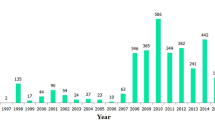Abstract
Enterovirus 71 (EV71) is a common cause of Hand, foot, and mouth disease (HFMD) and may also cause severe neurological diseases, such as encephalitis and poliomyelitis-like paralysis. To examine the genetic diversity of EV71, we determined and analyzed the complete VP1 sequences (891 nucleotides) from nine EV71 strains isolated in Fuyang, China. We found that nine EV71 strains isolated were over 98% homologous at the nucleotide level and 93%–100% homologous to members of the C4 subgenogroup. At the amino acid level, these Fuyang strains were 99%–100% homologous to one another, 97%–100% homologous to members of the C4 subgenogroup, and the histidine(H) at amino acid position 22 was conserved among the Fuyang strains. The results indicate that Fuyang isolates belong to genotype C4, and an H at position 22 appears to be a marker for the Fuyang strains.
Similar content being viewed by others
References
Bible J M, Pantelidis P, Chan P K, et al. 2007. Genetic evolution of enterovirus 71: epidemiological and pathological implications. Rev Med Virol, 17(6): 371–379.
Birgit O, Huang C-W, Daniela S, et al. 2009. Epidemiology of Enterovirus Types Causing Neurological Disease in Austria1999–2007: Detection of Clusters of Echovirus 30 and Enterovirus 71 and Analysis of Prevalent Genotypes. J Med Virol, 81: 317–324.
Brown B A, Oberste M S, Alexander J P, et al. 1999. Molecular epidemiology and evolution of enterovirus 71 strains isolated from 1970 to 1998. J Virol, 73: 9969–9975.
Cardosa M J, Perera D, Brown B A, et al. 2003. Molecular epidemiology of human enterovirus 71 strains and recent outbreaks in the Asia-Pacific region: comparative analysis of the VP1 and VP4 genes. Emerg Infect Dis, 9(4): 461–468
Chiu C H, Chu C, He C C, et al. 2006. Protection of neonatal mice from lethal enterovirus 71 infection by maternal immunization with attenuated Salmonella enterica serovar Typhimurium expressing VP1 of enterovirus 71. Micro Infect, 8(7): 1671–1678.
Damian G, Wei F, Sylvie A, et al. 2007. Identification of neutralizing linear epitopes from the VP1 capsid protein of Enterovirus 71 using synthetic peptides. Viru Res, 125: 61–68.
Dong X N, Yun J, Cheng Y H. 2007. Molecular epidemiology of enterovirus 71 in world, 1970–2004. J China Acade, 52(9): 1021–2027.
Helene N, Lotte B, Lars M, et al. 2003. Sequencing of ‘untypable’ enteroviruses reveals two new types, EV-77 and EV-78, within human enterovirus type B and substitutions in the BC loop of the VP1 protein for known types. J Genel Virol, 84: 827–836.
Herrero L J, Lee C S M, Hurrelbrink R J, et al. 2003. Molecular epidemiology of enterovirus 71 in peninsular Malaysia, 1997–2000. Arch Virol, 148: 1369–1385.
Huang Y P, Lin T L, Kuo C Y, et al. 2008. The circulation of subgenogroups B5 and C5 of enterovirus 71 in Taiwan from 2006 to 2007. Virus Res, 137(2): 206–212.
Jee Y M, Cheon D S, Kim K, et al. 2003. Genetic analysis of the VP1 region of human enterovirus 71 strains isolated in Korea during 2000. Arch Virol, 148: 1735–1746
Jon M B, Miren I G, Brian M, et al. 2008. Molecular Epidemiology of Human Enterovirus 71 in the United Kingdom from 1998 to 2006. J Clin Mirc, 46(10): 3192–3200.
Oberste M S, Maher K, Kilpatrick, D R, et al. 1999. Molecular evolution of the human enteroviruses: correlation of serotype with VP1 sequence and application to Picornavirus classification. J Virol, 73: 1941–1948.
Oberste M S, Maher K, Pallansch M A, et al. 1998. Molecular phylogeny of all human enterovirus serotypes based on comparison of sequences at the 5’end of the region encoding VP2. Virus Res, 58: 35–43.
Peter C M. 2002. An overview of the evolution of enterovirus 71 and its clinical and public health significance. FEMS Microbiol Rev, 26: 91–107.
Peter M, Katie L, David P, et al. 2001. Phylogenetic Analysis of Enterovirus 71 Strains Isolated during Linked Epidemics in Malaysia, Singapore, and Western Australia. J Virol, 75(16): 7732–7738.
Shih S R, Ho M S, Lin K H, et al. 2000. Genetic analysis of enterovirus 71 isolated from fatal and non-fatal cases of hand, foot and mouth disease during an epidemic in Taiwan, 1998. Virus Res, 68(2): 127–136.
Wu C N, Lin Y C, Fann C, et al. 2001. Protection against lethal enterovirus 71 infection in newborn mice by passive immunization with subunit VP1 vaccines and inactivated virus. Vaccine, 20(5–6): 895–904.
Author information
Authors and Affiliations
Corresponding author
Additional information
Foundation item: Scientific Research Fund of Institute of Pathogen Biology (2008IPB108)
Rights and permissions
About this article
Cite this article
Ma, Sh., Liu, Js., Wang, Jj. et al. Genetic analysis of the VP1 region of human enterovirus 71 strains isolated in Fuyang, China, during 2008. Virol. Sin. 24, 162–170 (2009). https://doi.org/10.1007/s12250-009-3033-4
Received:
Accepted:
Published:
Issue Date:
DOI: https://doi.org/10.1007/s12250-009-3033-4




